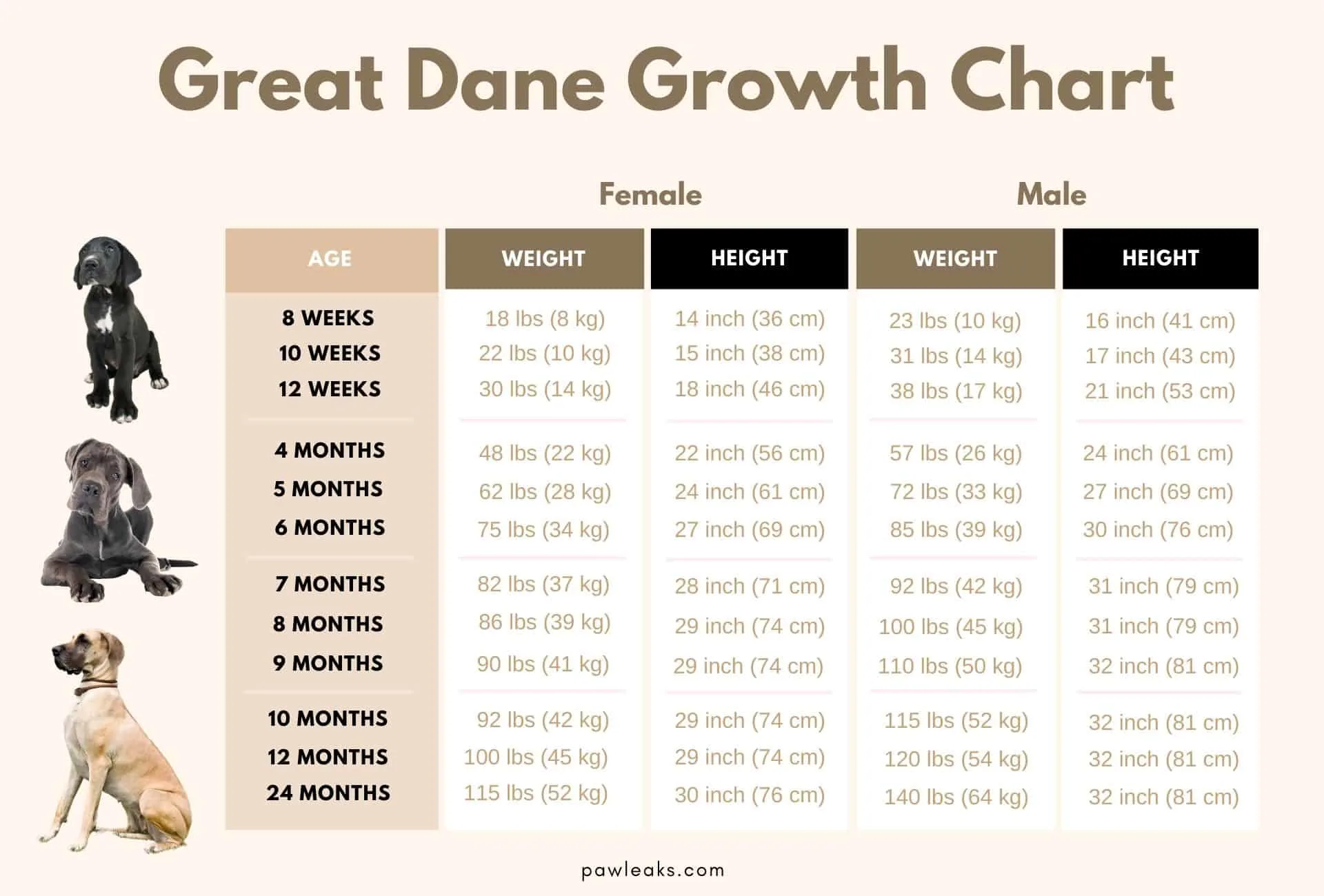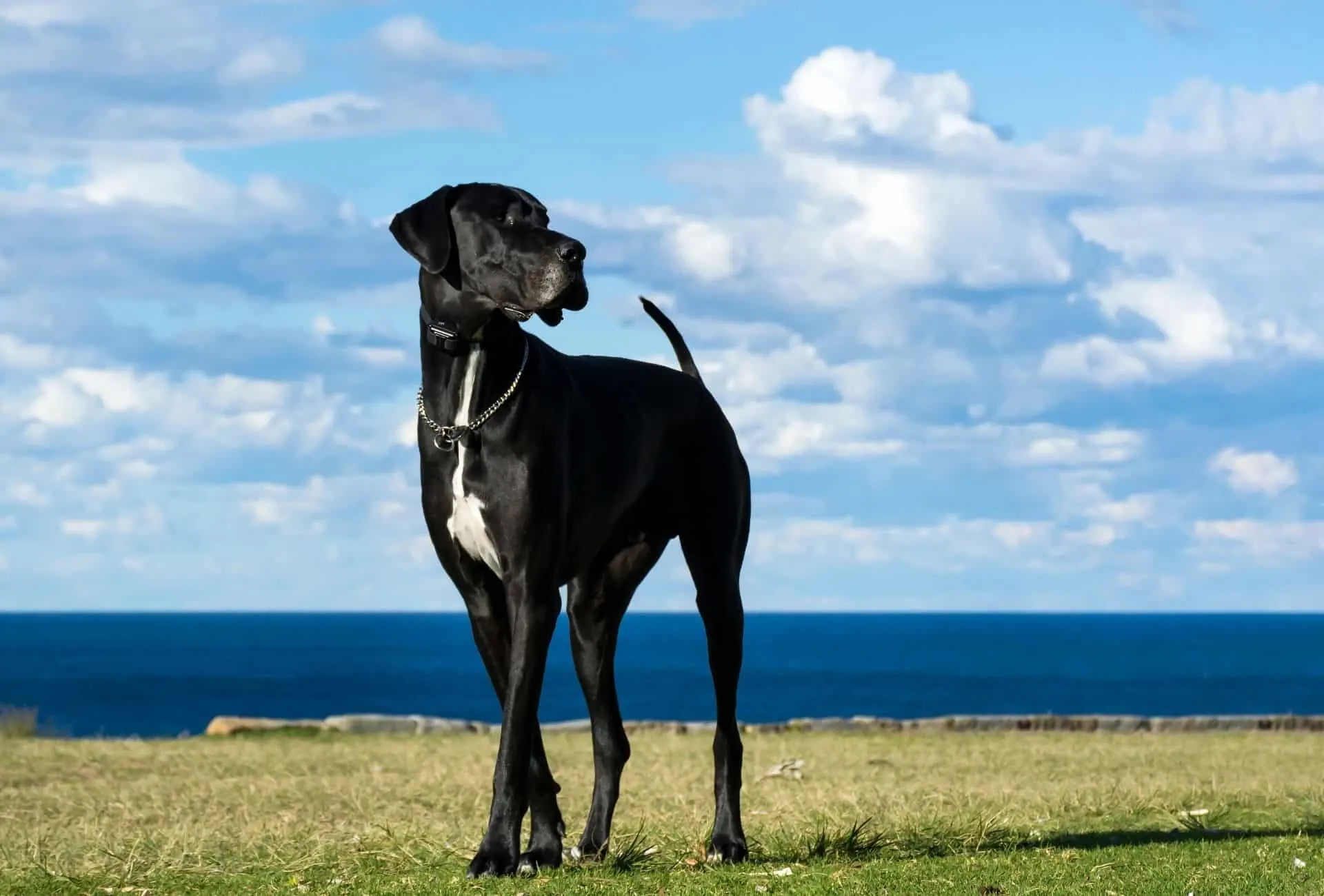The Great Dane is one of the largest dog breeds on the planet.
Surprisingly, the Great Dane doesn’t originate from Denmark. The Great Dane aka “Deutsche Dogge” or “German Mastiff” is a fellow German.
Whether you already got your Great Dane puppy or are on the brink of bringing one home, size probably matters to you in this case.
You are in the right place because we are going to explain all the facts about Great Dane growth that might interest any Great Dane owner.
Why is it so important to know what to expect while your pup is growing up?
Simply because your dog’s health and well-being depend on the growth rate.
Great Danes are gentle giants whose bodies can experience episodes of extreme growth.
During those episodes, the muscular-skeletal segments might not properly align and thus different diseases occur.
Generally speaking, all big dogs are prone to hip dysplasia, elbow dysplasia, and hygroma.
The first two are hereditary diseases (although some other factors can worsen the symptoms), while hygroma occurs when the dog puts too much pressure on the elbows.
For now, let’s focus on what to look out for in your puppy.
The first and most important thing is never to compare your pup to different litters.
There are always differences between two separate litters.
Moreover, there can even be significant height-weight fluctuations between individual puppies of the same litter.
A general recommendation is to buy a puppy from a reputable breeder that will let you meet your pup’s mom and dad.
Whatever the circumstances, the little Danes will have most of their parents’ physical traits.
As a buyer, you can ask for contacts of dog owners from previous litters and ask them about their experience.
A responsible breeder will be more than happy to assist you in making the right decision and give you their views on the growth of the puppies.
Great Dane Growth Chart
The following growth chart shows numbers that are only estimates and can’t be taken as a single effective method for predicting the pup’s future.
They just tell you what the pup may weigh at a certain age.

Here’s the chart in an easily readable format.
| Age | Weight (f) | Height (f) | Weight (m) | Height (m) |
|---|---|---|---|---|
| 8 Weeks | 18 lbs (8 kg) | 14 inch (36 cm) | 23 lbs (10 kg) | 16 inch (41 cm) |
| 10 Weeks | 22 lbs (10 kg) | 15 inch (38 cm) | 31 lbs (14 kg) | 17 inch (43 cm) |
| 12 Weeks | 30 lbs (14 kg) | 18 inch (46 cm) | 38 lbs (17 kg) | 21 inch (53 cm) |
| 4 Months | 48 lbs (22 kg) | 22 inch (56 cm) | 57 lbs (26 kg) | 24 inch (61 cm) |
| 5 Months | 62 lbs (28 kg) | 24 inch (61 cm) | 72 lbs (33 kg) | 27 inch (69 cm) |
| 6 Months | 75 lbs (34 kg) | 27 inch (69 cm) | 85 lbs (39 kg) | 30 inch (76 cm) |
| 7 Months | 82 lbs (37 kg) | 28 inch (71 cm) | 92 lbs (42 kg) | 31 inch (79 cm) |
| 8 Months | 86 lbs (39 kg) | 29 inch (74 cm) | 100 lbs (45 kg) | 31 inch (79 cm) |
| 9 Months | 90 lbs (41 kg) | 29 inch (74 cm) | 110 lbs (50 kg) | 32 inch (81 cm) |
| 10 Months | 92 lbs (42 kg) | 29 inch (74 cm) | 115 lbs (52 kg) | 32 inch (81 cm) |
| 12 Months | 100 lbs (45 kg) | 29 inch (74 cm) | 120 lbs (54 kg) | 32 inch (81 cm) |
| 24 Months | 115 lbs (52 kg) | 30 inch (76 cm) | 140 lbs (64 kg) | 32 inch (81 cm) |
If your dog is behind or ahead of these numbers, there is no need for concern.
All dogs are different and grow at different rates. Just continue feeding him quality food in carefully measured portions.
Also, keep in mind that there is a difference between American Great Danes and European Great Danes.
A certain height or weight goal is not something you need to strive towards but rather use as an approximate indicator.
If your puppy is stagnating, don’t jump to the conclusion that overfeeding or cranking up that exercise regimen will solve the issue.
Overfeeding can be especially harmful in giant breed dogs because obesity can trigger the health problems we mentioned before (hip and elbow dysplasia and hygroma).
Diet and exercise can spin the situation both ways.
Even though undernourishment is dangerous, fairly slimmer large and giant breed pups can avoid skeletal abnormalities in comparison to overweight pups.

During your dog’s life, you should only use quality food and follow strict feeding regimens.
The quantity of food, frequency of meals, and type of food change over time so make sure you know all the necessary facts.
Some puppies grow faster than others just to ultimately slow their growth and end up being on the smaller side of the litter.
If you have your eyes on a female baby, you can expect her to be a bit smaller than her brother.
For any concerns you might have your vet will help you either with a physical examination of the pup or just an informative talk.
Great Dane Growth Spurts
Great Danes grow in one year just as much as humans do in the initial 14 years of life.
Just like any other dog breed, they need to pass through growth spurts.
Keep in mind that during this period your GD pup might experience mild pain and also this is the time when dysplasia often develops.
The dog’s bloodline determines when the rapid growth phase will occur.
The biggest growth spurts happen when your Great Dane is between 4 and 6 months of age.
Sometimes the spurts happen earlier, at about 3 months of age.
Remember when we said that a late bloomer doesn’t need to be the smallest dog from the litter?
That’s true because a growth spurt can start as late as 12 months of age.
Signs that your Great Dane is experiencing a growth stage are:
- Frequent hiccup episodes
- Sleeping more than usual
- Painful reaction to touch
- Loss of appetite
- Fever
- Weakness
- Unexplained whimpering
Some symptoms are evident and some are not.
Because the Great Dane can gain 2 inches (5 cm) height within a week, his bones and ribs will become quite visible.
Diet can have a huge effect on the dog’s growth speed.
Feeding your Great Dane puppy food specifically for large breed dogs can assure they don’t go through massive growth spurts.
The good thing is that feeding your pup a large-breed puppy food won’t affect your dog’s adult size.
On the contrary, it can even promote it because the dog won’t go through all that stress and uncomfortable symptoms of rapid growth.
Great Danes need a long time to fully develop. There are many classifications of their developing stages.
According to one, there are 4 stages of development based on the dog’s stature.
The first stage is the puppy stage (7-8 weeks).
The average height for female pups at this age is 14 inches (36 cm) and for males is 16 inches (41 cm).
They weigh between 18 and 23 lbs (8-10 kg) with females striving for the lower end.
During the first few months, the bones grow at faster rates.
The second phase is more for muscle growth and development. That’s why puppies are less muscular before they are reproductively mature.
The second stage is when the dog already has half of the adult weight which is at about 5 months of age.
Males achieve a height of 27 inches (69 cm) and weight of 72 lbs (33 kg) and females are 24 inches (61 cm) tall and weigh around 62 lbs (28 kg).
8 months of age is the third growing stage in Great Danes.
When they are this old they already have 80% of their adult body developed.
Between 5 and 8 months of age, the female puppies are expected to gain 24 lbs (11 kg) in weight and 5 inches (13 cm) in height.
For males, the growth rate is 28 lbs (12 kg) and 4 inches (10 cm) respectively.
The final end boss is an adult Great Dane.
At What Age Are Great Danes Fully Grown?
Great Danes complete their physical development between 18 and 24 months of age.
Most dogs of this breed will already reach their final height at 18 months of age. Afterward, they continue bulking up with muscle until their second or third birthday.
How Big Will My Great Dane Get?
Full-grown adult female Great Danes weigh around 115 lbs (52 kg) and are 30 inches (78 cm). Male adults have 140 lbs (64 kg) of weight and around 32 inches (81 cm) in height.
As these numbers are average, some dogs can surpass or fail to meet them.
Some issues like shallow chest, straight legs, short muzzle, or roached back in puppies can reflect in their adult appearance, but that’s not a rule.
Some problems can also be medically treated so consult your vet if you have doubts about your pup’s growth.
A favorite method to predict the final size is to check the size of your pup’s paws and compare them to the rest of their slender body and ask the owner if it’s going to be a horse.
What is a Healthy Weight for a Great Dane?
The ideal weight for an adult Great Dane is between 115 lbs-140 lbs (52-64 kg).
The weight can only be ideal when it’s in correlation with the dog’s height.
For example, if an adult Great Dane male is 36 inches (91 cm), which is more than average, then 140 lbs (64 kg) isn’t necessarily a good target weight.
It’s important to acknowledge what lineage your Great Dane is coming from.
Does he have massive, bulky parents (and grandparents) or are they somewhat smaller?
Sometimes even big parents can produce somewhat smaller offspring.
Biological material, and in that manner genetic material, is a thing that constantly changes and adapts to new environmental conditions.
What you might see as an extremely large Great Dane or one below average can simply mean that the dog is just a part of the next generation.
Breeding of excessively huge specimens usually doesn’t end up too rosy for the Great Danes who often won’t go beyond 5-7 years of age.
If you are concerned about your dog’s weight simply ask a veterinarian that has experience with giant breeds.
Disclaimer: This blog post does not substitute veterinary attention and does not intend to do so. I am not a veterinarian or pet nutritionist. If your dog shows any sign of illness, call your vet.
Angela
Thursday 1st of June 2023
I find this article fascinating, I have a mixed Great Dane. She’s half Dane half golden retriever but looks like she’s all Dane. She just turned 6 months and is only 36 pounds but as tall as my full grown German Shepard. She’s definitely muscular and strong just tiny. She was also the tiniest one when I picked her up but they said she wasn’t the runt.